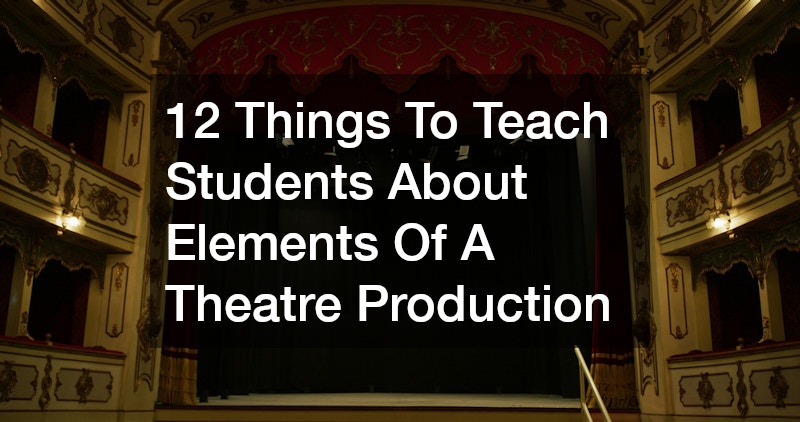
The magic of live theatre lies in its ability to transport an audience into another world—through stories, characters, and moments that feel larger than life. While actors take center stage, a production’s success depends on a team of creative minds and technical experts working together behind the scenes. For students interested in theatre, understanding the elements of a theatre production is essential not just to appreciate a performance, but to become a contributing part of it.
Whether you’re teaching middle schoolers in a drama club or high school students in a more formal program, it’s important to emphasize that theatre is a collaboration. Actors, directors, stage managers, designers, technicians, and many others play a crucial role in making a show come to life. Teaching students how these different roles work together offers them a well-rounded view of what theatre really is.
Moreover, many elements of theatre intersect with other educational paths. For example, students pursuing cosmetology school programs may find a passion for stage makeup and wigs. Those looking into welding schools might discover opportunities in set construction. Even students interested in audio video systems can contribute with skills in sound and lighting design.
Today’s theatre classrooms must be adaptable, well-equipped, and inspiring. This can range from specialized classroom flooring that accommodates movement and performance to practical resources like costumes, props, and office supplies for production planning.
Theatre education also supports pathways into the trades and professional opportunities, including union apprenticeships for stagehands, or entry into beauty schools for aspiring makeup artists and hairstylists. It’s even relevant in the context of some of the best private schools, which often offer state-of-the-art theatre facilities that expose students to high-quality productions.
This guide outlines 12 foundational things every student should learn about the elements of a theatre production. From lighting to set design, stage management to costumes, these topics will help young artists grow into thoughtful collaborators with a holistic understanding of how theatre works—both on and off the stage.
1. Script and Story

Everything in a theatre production starts with the script. It’s the blueprint for everything that follows—the dialogue, the characters, the themes, and the setting. Teaching students to analyze a script helps them understand structure, subtext, and emotional beats. The script also determines how other elements of a theatre production will evolve, including direction, design, and pacing.
Encouraging students to write or adapt their own scenes also nurtures creativity and teaches the importance of storytelling in theatre. Script work builds reading comprehension, critical thinking, and interpretation skills. Students learn to look beyond the words to find deeper meaning: Why does a character say this now? What themes are at play? What is the arc of the story?
Diving into different genres—comedy, tragedy, historical drama, modern realism—can expose students to a wide range of styles and storytelling techniques. Table reads, group discussions, and even basic dramaturgy help students understand context, setting, and intent. They also learn the value of script consistency and continuity, which are crucial when it comes to managing props, blocking, and tech cues.
This foundational knowledge gives students the language to speak with designers and directors, and allows them to approach theatre as more than just performance—it becomes interpretation. Students also learn that the story lives not only in the words but in how they’re delivered, staged, and supported by every other component of the production. This sets the stage for them to respect every role in the theatrical process and understand the creative ecosystem that starts with the written word.
2. Acting and Character Development
Acting is often the most visible part of a production. Teaching students acting fundamentals such as vocal projection, body language, and emotional expression will help them become confident performers. More importantly, they should learn how to build a character—exploring the character’s backstory, motivations, and relationships.
Students can start with simple monologues or two-person scenes to practice making strong choices. Encourage them to explore both internal and external elements of a character. Internally, they should ask: What does this character want? What obstacles do they face? What are their fears and goals? Externally, they experiment with posture, gestures, facial expressions, and vocal inflection to show those internal emotions physically.
Improvisation is also a useful tool for teaching adaptability and presence. It builds spontaneity and trust—skills that are essential in live theatre where anything can happen. Ensemble-building exercises can help actors connect with each other and learn to listen, respond, and collaborate onstage.
Roleplaying from the perspective of different characters—even those not written as the lead—teaches empathy. It invites students to step into someone else’s shoes, both literally and figuratively, and discover how even a small role can impact the whole.
As they gain more confidence, students can take part in scene study, where they explore how staging, pacing, and relationships affect a performance. These experiences reinforce how acting ties into the broader elements of a theatre production and is influenced by direction, set pieces, sound design, and more. Understanding this interconnectedness makes students more prepared and versatile theatre artists.
3. Directing and Vision
A director shapes the entire production. Teaching students about directing includes lessons on leadership, vision, and collaboration. They learn how to interpret the script, block scenes, and guide actors. Students can also explore how directors work with designers to bring their vision to life.
Students interested in directing should first learn how to “read a play like a director.” This means identifying the central conflict, key relationships, and turning points. Directors also consider the pacing, tone, and overarching message of the story. Exercises like comparing two interpretations of the same scene can show how directorial choices shift the meaning and impact.
Introduce students to blocking—the arrangement of movement on stage. Good blocking tells a story visually and enhances the emotional beats of a scene. Directors must think spatially, considering how to create dynamic pictures while maintaining balance and focus. Using tools like ground plans or simple stage maps helps students practice organizing space efficiently.
Directors also play a major role in casting and rehearsal management. They must communicate clearly, provide constructive feedback, and foster a safe, inclusive rehearsal environment. These leadership qualities are as important as artistic vision.
Working with designers is another critical component. Directors must articulate ideas for set, costume, lighting, and sound, collaborating to build a cohesive world. Bringing in design concepts and having students “pitch” their directorial vision helps them see how choices must align across departments.
Ultimately, students learn that directing is both an art and a craft. It involves deep analysis, big-picture thinking, and interpersonal skills. It teaches them how to unify all the elements of a theatre production into one cohesive, meaningful experience—and how to inspire others to help bring that vision to life.
4. Set Design and Construction

The set creates the physical world of the play. Students should learn how to read a ground plan and consider materials, scale, and mobility when designing sets. Collaborating on set building also introduces practical skills like carpentry, painting, and even metalwork—similar to what’s taught in welding schools.
Begin by teaching students how to analyze the script for clues about location, time period, and mood. What does the space say about the world of the play? Is it realistic or abstract? Static or transformable? They can sketch out their concepts on paper or use free software tools to create digital models. Even simple cardboard mockups can help them understand how to work in three dimensions.
Once the design is finalized, students can explore safe, hands-on construction. This might include building flats, platforms, and stairs, or learning how to rig backdrops. Emphasize tool safety, measuring, and working with various materials like wood, foam board, and fabric. Paint techniques, such as dry brushing or sponging, teach how to create realistic finishes or artistic textures.
Set design is also about problem-solving. How do you fit a two-story set on a small stage? How can a set piece be moved quickly during a scene change? These kinds of questions challenge students to be creative within constraints. Creative set designing can often include using unexpected elements or materials, like pallet racking.
Collaboration is key here—designers and builders must work closely with the director, lighting designer, and stage manager to ensure the set functions well for the story and the performers. For instance, a set that looks great but blocks sightlines or limits movement is ultimately ineffective.
Through set design, students gain an appreciation for the logistical and aesthetic roles of scenery. It reinforces the idea that the elements of a theatre production extend far beyond the script and actors, and that creating a visual world is a powerful storytelling tool in its own right.
5. Lighting Design
Lighting not only helps the audience see the actors—it sets mood, highlights action, and transitions between scenes. Students should learn how to read light plots, understand types of lighting instruments, and explore how color, intensity, and movement affect the atmosphere.
Introducing basic lighting design gives students a deeper appreciation for this often-overlooked but essential part of the elements of a theatre production.
6. Sound and Audio-Visual Integration
Sound design involves effects, music, and microphone work. Today’s productions often integrate full audio video systems to enhance storytelling with projections, background visuals, and dynamic soundscapes.
Teaching students how to use soundboards, cue music, and balance microphones opens doors to tech-related theatre roles. They gain problem-solving skills and a technical understanding that are invaluable in both theatre and broader AV careers.
7. Costumes and Wardrobe

Costumes help define characters’ identities, historical periods, and emotional arcs. Students should learn the basics of costume design—like fabric choice, color theory, and costume construction. Some schools partner with beauty schools to integrate hair and makeup into lessons. In other instances, an aspiring wig or makeup designer may attend cosmetology school programs prior to applying their skills in the theatre.
Introducing students to wardrobe duties, fittings, and costume maintenance prepares them for roles both behind the scenes and on the runway of creativity.
8. Makeup and Wigs
Theatrical makeup is not just about aesthetics—it enhances expression and visibility under stage lights. Teaching makeup skills includes contouring, aging, fantasy styles, and period-specific looks. Using professional tools and even exploring wigs for sale can help students build realistic and dramatic transformations.
Hands-on makeup sessions, even in basic theatre classrooms, teach both technical and artistic skills and help students appreciate how appearance supports character development.
9. Props and Set Dressing
Props add realism and detail to a scene. Whether it’s a teacup, a newspaper, or a sword, students should learn how to design, build, and manage props. Prop management includes labeling, tracking during rehearsals, and ensuring everything is show-ready.
Working with props ties into the overall theme of how the elements of a theatre production depend on precision and thoughtful collaboration.
10. Stage Management and Organization

Stage managers are the ultimate communicators and coordinators of a show. Teaching students how to create cue sheets, prompt books, rehearsal schedules, and backstage tracking documents introduces them to professional production standards.
Stage managers also need practical tools—everything from clipboards to gaffer tape—and yes, even office supplies like labels, binders, and calendars. They ensure every aspect of the show runs smoothly.
11. Theatre Safety and Technical Knowledge
Safety is a vital component of theatre education. Teaching students how to safely use ladders, tools, and lighting equipment is essential. Understanding how to move set pieces, secure wiring, and communicate during scene changes prevents accidents.
Lessons in technical safety often intersect with trade-related education, making them a bridge to union apprenticeship programs or backstage careers in professional theatre.
12. Rehearsals, Collaboration, and Respect
Last but certainly not least is the rehearsal process. Students should learn the importance of showing up on time, taking direction, and respecting their peers’ contributions. Rehearsals are where the elements of a theatre production come together, requiring patience, flexibility, and open communication.
Creating a classroom culture of collaboration, especially in schools with strong arts support like some of the best private schools, empowers students to value every voice in the room.
Teaching students the elements of a theatre production is about more than just putting on a play—it’s about giving them a language to understand how creativity, structure, and teamwork intersect. Whether they pursue a future onstage, backstage, or elsewhere, these lessons instill values that apply far beyond the theatre.
For some students, theatre may inspire academic or professional pathways. Learning makeup and wigs may guide them toward beauty schools or cosmetology school programs, while building sets and working with tools could lead to welding schools or union apprenticeship opportunities. Tech-savvy students might lean into the audio video system side of productions, gaining valuable experience with equipment and digital storytelling.
Theatre classrooms should be as thoughtfully designed as the productions themselves—incorporating durable classroom flooring, modular seating, and accessible storage. Even everyday tools like office supplies help support the planning and organization that theatrical work demands.
Outside the classroom, students may find themselves further inspired by visits to community theatres, professional performances, or arts-rich learning environments like those found in the best private schools. These experiences show students what’s possible when the elements of a theatre production are elevated to a professional level.
Ultimately, theatre teaches students to be resilient, resourceful, and respectful—three skills that serve them in any field. As educators, the goal is to give young people a full understanding of what goes into a performance, from the first script read-through to the final curtain call. That understanding breeds appreciation, opens doors, and builds confidence.
And in a world increasingly focused on automation and efficiency, there’s something deeply human about the communal nature of theatre. By teaching the full scope of the elements of a theatre production, we give students the tools to tell stories—and perhaps even change the world with them.


